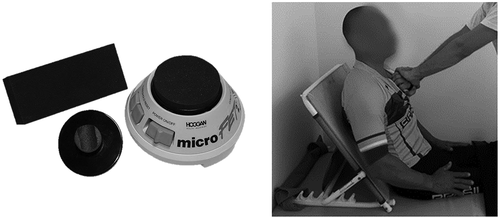Figures & data
Table 1. Number of time-trial results included in the analysis per sex and spinal cord injury level group
Figure 1. Handheld dynamometer device (MicroFET2 ProCare) (left), and position of the athlete during trunk flexion test (right)

Table 2. Multilevel models (Levels: Event and Athlete) assessing the differences in average time-trial velocity among pairs of SCI groups, with Th1–Th5, Th6–Th9 and Th10–L1 as a reference after controlling for age, sex (male = 1; female = 0), and AIS differences (AIS A/B = 1; AIS C/D = 0). Β = unstandardised beta values; SE = standard error; CI = confidence interval
Figure 2. Scatterplot of trunk flexion strength and average time-trial velocity. Data points are identified by sex and by handcycling class. (H3: spinal cord injury with lesion levels between Th1 and Th10; H4 lesion levels below Th11 or amputations)

Figure 3. Scatterplots of trunk flexion strength and handcycling performance during a 20-sec isokinetic sprint: Mean PO (upper graph) and Peak PO (lower graph). data points are identified by sex and by handcycling class. (H3: spinal cord injury with lesion levels between Th1 and Th10; H4 lesion levels below Th11 or amputations)

